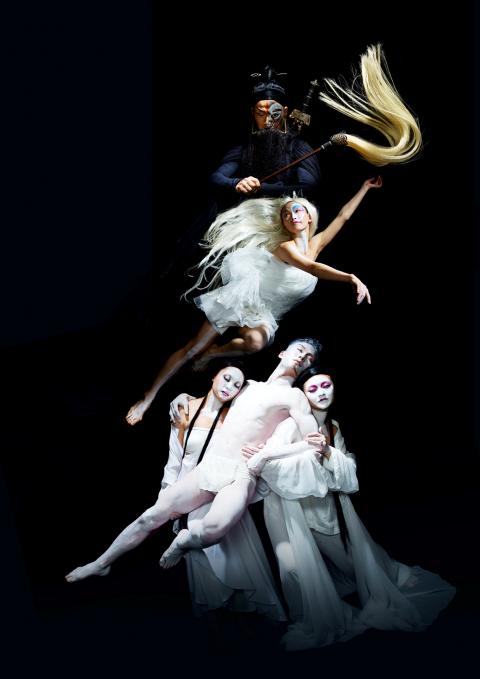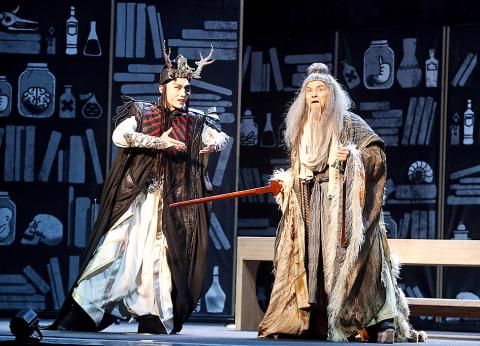The Contemporary Legend Theatre (當代傳奇劇場), Taiwan’s jingju (Beijing opera, 京劇)-fusion troupe may be small, but artistic director Wu Hsing-kuo (吳興國) has never let it hold them back from tackling big plays. His one-man show of Shakespeare’s King Lear was a testament to that.
However, with Johann Wolfgang von Goethe’s monumental Faust, Wu and scriptwriter/choreographer Lin Hsiu-wei (林秀偉) might have bitten off more than they could chew.
I say might, because the production I saw at Taipei’s Zhongshan Hall on Saturday night as part of the Taipei Arts Festival has a lot of potential, but needs some reworking and trimming to become a strong piece for the troupe.

Photo Courtesy of Kuo Cheng-chang
There is a reason why most theatrical or operatic versions of Faust stick with part I of Goethe’s magnum opus; there is just too much to cover in part II.
I certainly got the feeling that the company was rushing to wrap up its Act II to be able to finish the show within three hours: After Faust meets Helen of Troy and their son, Euphorion, is killed in battle, video montages are used to speed through the storyline to get Faust back to his library.
Since the montages are by visual projection master — and the go-to-man for dance and theater troupes such as Cloud Gate Dance Theatre (雲門舞集) — Ethan Wang (王奕盛), they are stunning, but it did seem like rifling through the pages of a huge book to get from page 500 to 900 in order to read the last 10 pages and finish the story.

Photo: CNA
However, there is so much to like in this production.
Wu remains at the height of his powers, transitioning from a very old Faust to Mephistopheles and back again.
All 11 performers played a multitude of roles. The young Chu Po-cheng (朱柏澄), who plays the younger Faust as well as Mephistopheles, and gets to show of his jingju acrobatic skills as the court jester, was very good.
Jolin Huang’s (黃若琳) made a stronger impression as Gretchen, than Chang Shuo-ting (張碩庭) did as Helen, while Huang Yi-hao (黃逸豪 ) stood out as the emperor and Lin Sheng-lun (林聖倫) as his prime minister.
The costumes by Kang Yan-ling (康延齡) were stunning, especially Faust’s fur robe, and the witches’ hill tribe-influenced costumes, which came with their massive headpieces and masks created by Chang Wang (張忘).
Architect Ricky Liu’s (劉培森) two-level modular design was far more complicated than many of the company’s sets for previous productions. It worked well for the most part, with the walls of books in Faust’s library turning around to become city walls, and a space at the upper right for key musicians, but then the boulder-strewn “Limbo” section that opens Act II looked slapdash.
Wang’s projections were stunning as always, especially the burning tree in the initial scene, the starry sky for the Limbo section, the crashing waves of the beginning of the Helen segment, and the skeleton-like face of Mephistopheles and Wu as the older Faust that loom above the set towards the end of Act II.
The two surtitle screens on either side of the stage provided crisp, easy to read Chinese characters and English translations of the dialogue and songs, which were in a modern vernacular, rather than more classical style.
Perhaps this was a concession designed to win over a younger audience — a problem faced by opera troupes the world over, but it did make for some jarring moments.
I was not expecting Faust, lamenting about the years he spent closeted in his library, to say “Who am I but a nerd?” — or the jester to joke about “taking a shit” — or Mephistopheles, when asked by Faust what he was digging to say: “Your grave, bro.”
However, it was all part and parcel of a fun evening with Faust — which is something that I would not expect to say.
The company will perform Faust at the Chiayi Performing Arts Center (嘉義縣表演藝術中心演藝廳) on Sept. 30. Tickets run from NT$800 to NT$3,000 and are available online at www.artsticket.com.tw, at convenience store ticketing kiosks and at the door.
If you live down south, while Faust is not a great show yet, it is worth a bet — though not of your soul — and three hours of your life to see it.

Taiwan Power Co (Taipower, 台電) and the New Taipei City Government in May last year agreed to allow the activation of a spent fuel storage facility for the Jinshan Nuclear Power Plant in Shihmen District (石門). The deal ended eleven years of legal wrangling. According to the Taipower announcement, the city government engaged in repeated delays, failing to approve water and soil conservation plans. Taipower said at the time that plans for another dry storage facility for the Guosheng Nuclear Power Plant in New Taipei City’s Wanli District (萬里) remained stuck in legal limbo. Later that year an agreement was reached

What does the Taiwan People’s Party (TPP) in the Huang Kuo-chang (黃國昌) era stand for? What sets it apart from their allies, the Chinese Nationalist Party (KMT)? With some shifts in tone and emphasis, the KMT’s stances have not changed significantly since the late 2000s and the era of former president Ma Ying-jeou (馬英九). The Democratic Progressive Party’s (DPP) current platform formed in the mid-2010s under the guidance of Tsai Ing-wen (蔡英文), and current President William Lai (賴清德) campaigned on continuity. Though their ideological stances may be a bit stale, they have the advantage of being broadly understood by the voters.

In a high-rise office building in Taipei’s government district, the primary agency for maintaining links to Thailand’s 108 Yunnan villages — which are home to a population of around 200,000 descendants of the Chinese Nationalist Party (KMT) armies stranded in Thailand following the Chinese Civil War — is the Overseas Community Affairs Council (OCAC). Established in China in 1926, the OCAC was born of a mandate to support Chinese education, culture and economic development in far flung Chinese diaspora communities, which, especially in southeast Asia, had underwritten the military insurgencies against the Qing Dynasty that led to the founding of

Artifacts found at archeological sites in France and Spain along the Bay of Biscay shoreline show that humans have been crafting tools from whale bones since more than 20,000 years ago, illustrating anew the resourcefulness of prehistoric people. The tools, primarily hunting implements such as projectile points, were fashioned from the bones of at least five species of large whales, the researchers said. Bones from sperm whales were the most abundant, followed by fin whales, gray whales, right or bowhead whales — two species indistinguishable with the analytical method used in the study — and blue whales. With seafaring capabilities by humans